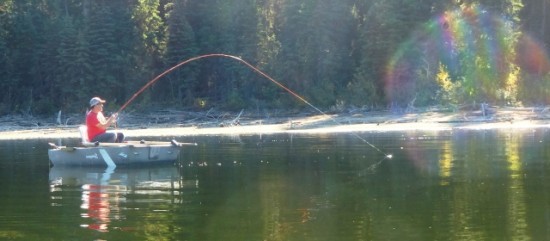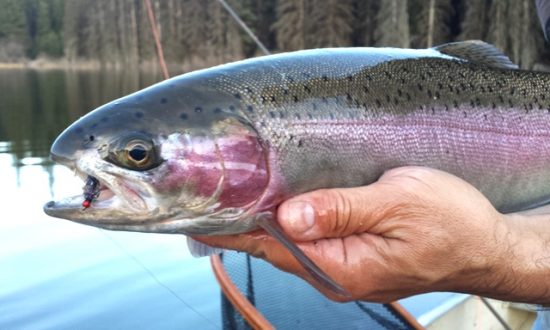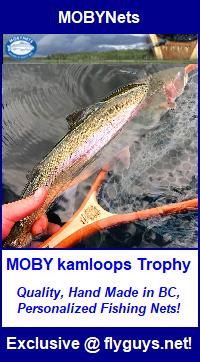Early Spring Fly Fishing Strategies …
In the pacific northwest, particularly in the interior of BC and Washington, spring stillwater fly-angling is often referred to as “chironomid season”. With an abundance of lakes where spring emergences are dominated by little dipterans of the taxonomic family Chironomidae (and to a lesser extent Chaoboridae), the colloquial term “chironomid season” is fitting.
Over the last 2 decades, tactics employing the imitation of chironomids with artificial flies has gone from virtually occult to dominating the stillwater fly-angling effort. Perhaps it is because effective chironomids can be tied reasonably inexpensively and quickly. Perhaps it has more to do with the fact that chironomids can reliably be fished by a static presentation which requires little effort but is still hugely productive. Maybe it’s just because they catch fish, period. But whatever the case might be, anglers have embraced spring chironomid fishing season… maybe a little too much.
Anglers now use chironomids to such an extent that at many have forgotten that they don’t just start coming off in clouds as the ice is peeling off. If there is such thing as the “chironomid season”, there is also such thing as the “pre-chironomid season”. Here are a few facts and considerations to help you on those tough days before chironomids emerge en mass. 🙂
Pre Chironomid Season Early Spring Fly Fishing Strategies
– Insects & Fly Patterns –
Immature Damsels and Mayflies
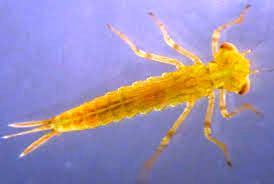 Both damselflies (Suborder Zygoptera) and Mayflies (Order ephemeroptera) go through multiple stages of development, or instars, between the egg and adult life stages, which is often a multi-year period. What this means is that in lakes with significant populations of either, the immature stages of these insects can offer a significant food source. At times, fish will become quite selective on these immature stages, and while most anglers have patterns to represent emergence-time insects, few have patterns t
Both damselflies (Suborder Zygoptera) and Mayflies (Order ephemeroptera) go through multiple stages of development, or instars, between the egg and adult life stages, which is often a multi-year period. What this means is that in lakes with significant populations of either, the immature stages of these insects can offer a significant food source. At times, fish will become quite selective on these immature stages, and while most anglers have patterns to represent emergence-time insects, few have patterns t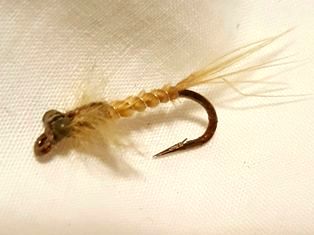 o represent immature specimens. For example, it would be common to fish a damsel pattern during the emergence period, which in the BC interior peaks (broadly) early to mid-June. Damsels that are maturing and migrating to shoreline vegetation to hatch would be roughly 30 mm in length. Immature damsels that attract the attention of fish in early spring might range from 10-25 mm.
o represent immature specimens. For example, it would be common to fish a damsel pattern during the emergence period, which in the BC interior peaks (broadly) early to mid-June. Damsels that are maturing and migrating to shoreline vegetation to hatch would be roughly 30 mm in length. Immature damsels that attract the attention of fish in early spring might range from 10-25 mm.
Similarly, a callibaetis mayfly nymph (most common species in BC interior stillwaters) would be about 20 mm at emergence in late May but immature specimens commonly found in early spring stomach samples are often less than half that. Anglers prepared for instances where trout key on immature stages of these insects will have patterns representing their smaller sizes. What’s that you say? You are all thumbs and dread the prospect of scaling down your favorite damsel and/or mayfly patterns to indiscernible sizes? I have good news! As patterns get smaller, the detail required to be appealing to fish seems to diminish. Even better is that select patterns seem to be great generalists, doing a reasonable job imitating both species.
This generic bead-head nymph with a tan or watery green body tied on a size 14 or 16 long shank is a simple tie and an ultra-effective pattern. It can be fished on a floating line with a slow retrieve, or even static (or almost so) under an indicator.
bead-head nymph with a tan or watery green body tied on a size 14 or 16 long shank is a simple tie and an ultra-effective pattern. It can be fished on a floating line with a slow retrieve, or even static (or almost so) under an indicator.
Bloodworms
 Good chironomid lakes have high densities of chironomids, and hence of the larval form of the insect, commonly called “bloodworms”. As this name suggests, the larvae tend most often to be various shades on the deeper side of red, although they can be various shades of green or mixed green and red too. Although bloodworms are usually in or on the bottom substrate, wind-generated currents can often lift them off the bottom, where the little fish-delicacies are highly susceptible to becoming trout snacks.
Good chironomid lakes have high densities of chironomids, and hence of the larval form of the insect, commonly called “bloodworms”. As this name suggests, the larvae tend most often to be various shades on the deeper side of red, although they can be various shades of green or mixed green and red too. Although bloodworms are usually in or on the bottom substrate, wind-generated currents can often lift them off the bottom, where the little fish-delicacies are highly susceptible to becoming trout snacks. 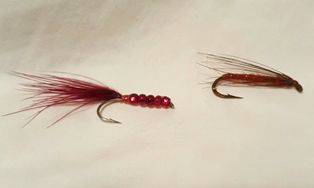 There are a ton of effective bloodworm patterns, and generally, they should be fished close to bottom. With so many patterns available, everyone seems to have a fave. Personally, I have had best luck with patterns that have some soft material that moves in the water, i.e. a sparse, soft hackle or a marabou tail. Don’t be afraid to go big! Any lake with a “bomber” chironomid hatch will hold bloodworms over 30 mm long and over 2mm thick.
There are a ton of effective bloodworm patterns, and generally, they should be fished close to bottom. With so many patterns available, everyone seems to have a fave. Personally, I have had best luck with patterns that have some soft material that moves in the water, i.e. a sparse, soft hackle or a marabou tail. Don’t be afraid to go big! Any lake with a “bomber” chironomid hatch will hold bloodworms over 30 mm long and over 2mm thick.
Leeches
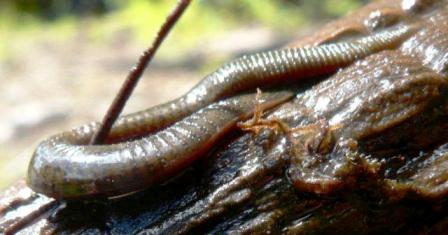
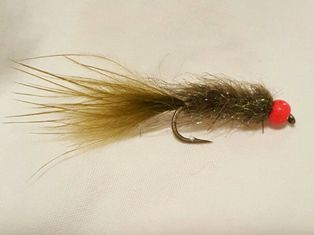 Leeches and other leech-like attractors must be the most seasonally versatile flies in the box when it comes to stillwaters in BC. Depending on the pattern, they might pulsate, undulate, sparkle, rattle, slither over weeds and through marl, shimmer and/or shine. Even when fish are keyed on other food items, it’s not often when a well presented leech is snubbed. And, at times including but not limited to the early season, fish key in on leeche
Leeches and other leech-like attractors must be the most seasonally versatile flies in the box when it comes to stillwaters in BC. Depending on the pattern, they might pulsate, undulate, sparkle, rattle, slither over weeds and through marl, shimmer and/or shine. Even when fish are keyed on other food items, it’s not often when a well presented leech is snubbed. And, at times including but not limited to the early season, fish key in on leeche s too. When they are, it pays dividends to have a selection of realistic colors, which would include black, medium to d
s too. When they are, it pays dividends to have a selection of realistic colors, which would include black, medium to d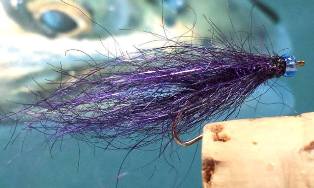 ark browns, medium to dark maroons, dark olive and sometimes lighter colors like tan to almost mauve. Not too glitzy. Other times, the patterns that look like the leech is going to a rave are winners. Shiny beads, reflective, pearlescent, iridescent, flamboyant materials can make deadly patterns. Lately, my favorite patterns have been incorporating fluorescent beads including hot pink, blaze orange and chartreuse.
ark browns, medium to dark maroons, dark olive and sometimes lighter colors like tan to almost mauve. Not too glitzy. Other times, the patterns that look like the leech is going to a rave are winners. Shiny beads, reflective, pearlescent, iridescent, flamboyant materials can make deadly patterns. Lately, my favorite patterns have been incorporating fluorescent beads including hot pink, blaze orange and chartreuse.
Shrimp/Scuds
Many lakes have prolific populations of freshwater amphipods, commonly called “scuds”, or “shrimp”. When they do, trout inhabiting these lakes will feed extensively, year round on these tiny crustaceans. Incidental encounters of trout and scuds rarely end well for the scud. But scuds are also a target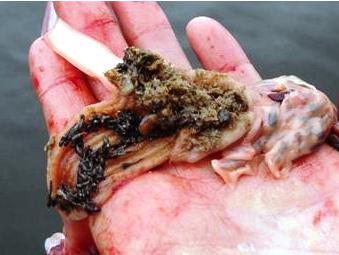 ed, mainstay food item in periods of summer, late fall, winter, and at ice-off before chironomid hatches flourish. Actually, even during the chironomid “season”, scuds are often in stomach samples of fish caught before or early in the chironomid hatch. The adjacent image illustrates this well: scuds in the pit of the stomach, chironomids closer to the throat.
ed, mainstay food item in periods of summer, late fall, winter, and at ice-off before chironomid hatches flourish. Actually, even during the chironomid “season”, scuds are often in stomach samples of fish caught before or early in the chironomid hatch. The adjacent image illustrates this well: scuds in the pit of the stomach, chironomids closer to the throat.
Note that scuds which have been subject to stomach acids will appear orange. Many anglers mistakenly believe that the fish are keyed in on orange scuds and tie patterns accordingly, with little success. Scuds range from tan, beige, almost a steel grey/light blue, to various earthy shades of brown and olive.
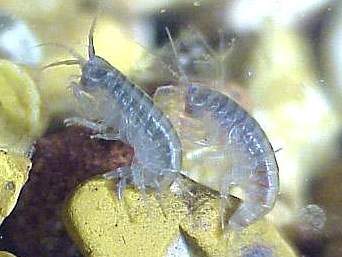
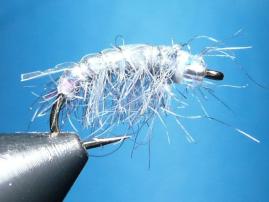 In the BC interior & pacific northwest, two genus of scuds are prominent. Both of, one of, or neither of Hyalella and Gammarus may inhabit a lake. With respect to the fly angler, imitating the larger (generally 10-15mm) Gammarus is preferred, since Hyalella are usually less than 6mm in length. Gammarus are commonly found in proximity to macrophytes (water plants) such as milfoil or chara, while Hyalella are abundant in/on mud, sand, silt, or marl, which is the light colored Calcium carbonate-rich
In the BC interior & pacific northwest, two genus of scuds are prominent. Both of, one of, or neither of Hyalella and Gammarus may inhabit a lake. With respect to the fly angler, imitating the larger (generally 10-15mm) Gammarus is preferred, since Hyalella are usually less than 6mm in length. Gammarus are commonly found in proximity to macrophytes (water plants) such as milfoil or chara, while Hyalella are abundant in/on mud, sand, silt, or marl, which is the light colored Calcium carbonate-rich 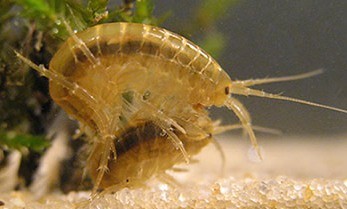 mud common in clear water, alkaline lakes. A phenomenon that is more common after spring chironomid hatches than it is before is for trout to selectively pick Hyalella out of the marl. Regardless of when this happens, a small (size 18-20ish) pattern and a lot of patience can pay off. Imitations need to be fished near, or practically on, bottom. Floating lines and long leaders are the usual method of accomplishing this. Gammarus patterns, on the other hand, can be fished retrieved on various line types or static with a floating line and indicator, and although being close to bottom is preferred, it is less critical as they may swim at depths throughout the water column, including right at
mud common in clear water, alkaline lakes. A phenomenon that is more common after spring chironomid hatches than it is before is for trout to selectively pick Hyalella out of the marl. Regardless of when this happens, a small (size 18-20ish) pattern and a lot of patience can pay off. Imitations need to be fished near, or practically on, bottom. Floating lines and long leaders are the usual method of accomplishing this. Gammarus patterns, on the other hand, can be fished retrieved on various line types or static with a floating line and indicator, and although being close to bottom is preferred, it is less critical as they may swim at depths throughout the water column, including right at
surface. A favourite tactic is to fish scuds along the bottom edge of macrophyte “walls”, where beds of these aquatic plants stretch from the surface often to considerable depths (10’-12’). These conditions, however, are rarely present in early spring when macrophytes have been dying and decomposing under the lightless cover of ice and snow, and usually macrophytes will take until early summer to establish themselves to that extent.
Scuds, especially Gammarus, have low thresholds for water acidity. They need calcium to maintain their exoskeletons, and waters high in calcium are inherently basic (the opposite of acidic).
Water Boatmen/Backswimmers
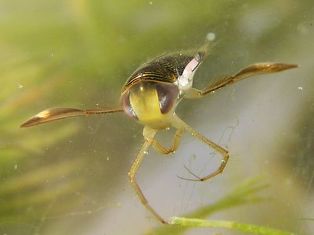
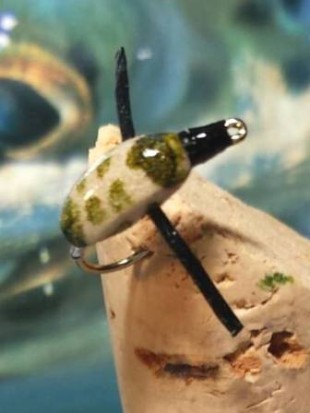 For the most part and with notable exceptions, spring fishing concentrates on boatmen rather than their larger relatives the backswimmers. Somewhat counter-intuitively, boatmen are at their biggest in early spring, as adults over-winter under ice and then lay eggs in early spring. Thus, unlike other invertebrates imitated by the fly angler, full size patterns are used in spring and fall, with smaller juvenile patterns used throughout summer, although boatmen seem to at
For the most part and with notable exceptions, spring fishing concentrates on boatmen rather than their larger relatives the backswimmers. Somewhat counter-intuitively, boatmen are at their biggest in early spring, as adults over-winter under ice and then lay eggs in early spring. Thus, unlike other invertebrates imitated by the fly angler, full size patterns are used in spring and fall, with smaller juvenile patterns used throughout summer, although boatmen seem to at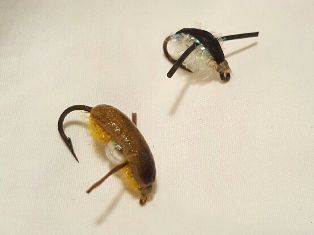 tract limited attention from fish outside of spring and autumn. Since boatmen breathe air and have to make trips to the surface to collect the tiny, shiny air bubble that imitations should incorporate on the belly of the fly, these insects tend to stick to somewhat shallow (less than 12’) water. Floating patterns are typically fished on sinking lines, and sinking patterns usually on floating lines.
tract limited attention from fish outside of spring and autumn. Since boatmen breathe air and have to make trips to the surface to collect the tiny, shiny air bubble that imitations should incorporate on the belly of the fly, these insects tend to stick to somewhat shallow (less than 12’) water. Floating patterns are typically fished on sinking lines, and sinking patterns usually on floating lines.
Caddis Larvae
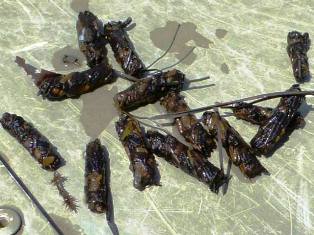 When trout anglers think of the caddisfly, a.k.a. the sedgefly, (usually abbreviated to “caddis” or “sedge”), we think of splashy rises or deep surface boils as fish engulf newly (or previously) hatched adults. While this romantic image epitomizes what fly fishing trout is all about for many anglers, the somewhat less romantic act of hooking early season slabs on bottom-crawled cased caddis larva patterns seems to do the trick just fine for me. Any lake with a good summer Limnephilidae caddis hatch (the most common family of case dwelling caddis in North America) will have plenty of cased larvae meandering macrophyte stems and marl flats. To the caddisfly, the little case which they call home is all the security they need to make feeding forays to the haunts where other lake dwellers, namely hungry trout, make feeding forays of their own. Fish will pounce on these larvae, case and all, and seem to pay little attention to the side-dish of sticks, pebbles, leaves, and other organic/vegetative matter that accompany the plump grub inside.
When trout anglers think of the caddisfly, a.k.a. the sedgefly, (usually abbreviated to “caddis” or “sedge”), we think of splashy rises or deep surface boils as fish engulf newly (or previously) hatched adults. While this romantic image epitomizes what fly fishing trout is all about for many anglers, the somewhat less romantic act of hooking early season slabs on bottom-crawled cased caddis larva patterns seems to do the trick just fine for me. Any lake with a good summer Limnephilidae caddis hatch (the most common family of case dwelling caddis in North America) will have plenty of cased larvae meandering macrophyte stems and marl flats. To the caddisfly, the little case which they call home is all the security they need to make feeding forays to the haunts where other lake dwellers, namely hungry trout, make feeding forays of their own. Fish will pounce on these larvae, case and all, and seem to pay little attention to the side-dish of sticks, pebbles, leaves, and other organic/vegetative matter that accompany the plump grub inside.
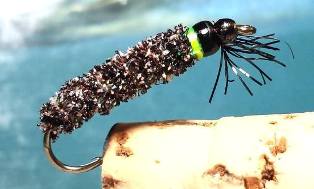 Caddisfly larvae are slow crawlers, so patterns are best fished with a very slow retrieve on bottom. Working patterns along the marl or just over the chara is a deadly way to fool caddis-seeking trout. Much like fishing any fly in the marl, takes are generally soft. Trout will often “peck” at the fly before they finally grab hold, and it takes considerable restraint not to set on the take too soon!!
Caddisfly larvae are slow crawlers, so patterns are best fished with a very slow retrieve on bottom. Working patterns along the marl or just over the chara is a deadly way to fool caddis-seeking trout. Much like fishing any fly in the marl, takes are generally soft. Trout will often “peck” at the fly before they finally grab hold, and it takes considerable restraint not to set on the take too soon!!
Patterns range from the old-school (but deadly at times) Wooly worm, to patterns incorporating segmented chenille or burnt chenille to imitate the spiraled or conglomerate type cases that predominate at the time.
Immature Dragonflies
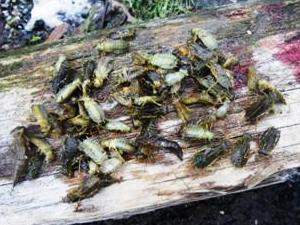 Like their cousins the damsels, dragonflies (suborder Anisoptera) live as nymphs, usually for multiple years, before clamoring out of the water and emerging as an adult. Two broad categories of dragonfly nymphs are imitated by fly anglers. Without over complicating the taxonomy, let’s call them darting dragonflies (usually family Aeshnidae) and crawling dragonflies (usually family Libellulidae). The darters are capable of “darting” through the water, both as a feeding strategy or a predator avoidance one. As such, they are longer, more streamlined, and generally hairless to facilitate their swimming. The crawlers rely on camouflage to avoid predators, as such, their body features are geared to facilitate their hi
Like their cousins the damsels, dragonflies (suborder Anisoptera) live as nymphs, usually for multiple years, before clamoring out of the water and emerging as an adult. Two broad categories of dragonfly nymphs are imitated by fly anglers. Without over complicating the taxonomy, let’s call them darting dragonflies (usually family Aeshnidae) and crawling dragonflies (usually family Libellulidae). The darters are capable of “darting” through the water, both as a feeding strategy or a predator avoidance one. As such, they are longer, more streamlined, and generally hairless to facilitate their swimming. The crawlers rely on camouflage to avoid predators, as such, their body features are geared to facilitate their hi ding. They are stout, hairy and blend into their surroundings well. The body shape and habits of the two nymph types is an important factor of how the pattern should look and how it should be fished. Because darting dragonfly nymphs will dart when threatened, the retrieve often employs quick strips or spurts amongst a slower retrieve, and the fly imitates the slender body shape. Imitating crawling dragonfly nymphs employs a stout pattern crawled very slowly. Because the slow retrieve causes the fly to be prone to hanging up easily on bottom, patterns are often tied using buoyant materials like deer hair.
ding. They are stout, hairy and blend into their surroundings well. The body shape and habits of the two nymph types is an important factor of how the pattern should look and how it should be fished. Because darting dragonfly nymphs will dart when threatened, the retrieve often employs quick strips or spurts amongst a slower retrieve, and the fly imitates the slender body shape. Imitating crawling dragonfly nymphs employs a stout pattern crawled very slowly. Because the slow retrieve causes the fly to be prone to hanging up easily on bottom, patterns are often tied using buoyant materials like deer hair.
Trout encounter dragonfly nymphs of various life stages on a regular basis before the main emergence takes place. Often, the immature nymphs will be abund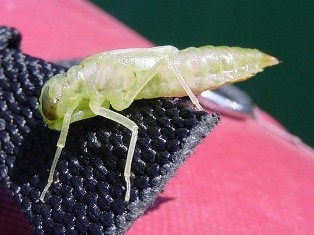 ant enough that trout will selectively key in on them. Key differences between immature nymphs and emerging ones are color, size and size of the wing case. Juvenile nymphs that have recently molted are light green in color, whereas emerging nymphs have been in their case a while and are usually dark olive or brown. Juveniles will often be less than 30 mm and 20 mm for the darters and crawlers respectively, as opposed to +/- 45 mm and 30mm for the respective emerger sizes. Lastly, emerging nymphs will need to take flight after emergence and hence have well developed wing cases, which are worthwhile of including on patterns. Immature nymphs have poorly developed wing cases and patterns often omit them altogether.
ant enough that trout will selectively key in on them. Key differences between immature nymphs and emerging ones are color, size and size of the wing case. Juvenile nymphs that have recently molted are light green in color, whereas emerging nymphs have been in their case a while and are usually dark olive or brown. Juveniles will often be less than 30 mm and 20 mm for the darters and crawlers respectively, as opposed to +/- 45 mm and 30mm for the respective emerger sizes. Lastly, emerging nymphs will need to take flight after emergence and hence have well developed wing cases, which are worthwhile of including on patterns. Immature nymphs have poorly developed wing cases and patterns often omit them altogether.
A final note on fly patterns …….
Pre Chironomid Season Early Spring Fly Fishing Strategies
– Fish Location –
Because the pre-chironomid period is shortly after ice off, anglers should consider a few noteworthy points when looking for fish:
Oxygen may be limited to shallow water in some instances (especially in small, productive lakes), and whether it’s dissolved oxygen or feeding preferences, early spring fish often exhibit clumped distribution. Boom or bust, one might say; if you find them, you’ll find a bunch, but if not, you’ll be wondering if there are any fish in the lake!
Here in the BC southern interior, river and stillwater flyfishing opportunities begin to become available as winter loses its grip (as early as February) in the main valley bottoms, with the trend continuing upward in elevation as the season progresses. Although this article precludes naming local early season fisheries, those seeking early season soft water where they can employ the aforementioned tactics may be interested in reading the “Early Spring Fishing – Kamloops Style” article below.
Pre Chironomid Season Early Spring Fly Fishing Strategies
– Conclusion –
By now you might be thinking that you need to be an entomologist to know when and where and why the fish are doing what they are. Try to keep it simple. Get fish the best way you know how and get a stomach sample. From there, look for patterns that are as close to the stomach contents as possible, and experiment with the retrieve, etc. When you find what works, repeat it. Most of all, enjoy your local fisheries!
And last but not least, here’s another associated article describing, in detail, how to tie six proven BC Interior stillwater pre hatch flies 🙂
Fish on!
Benny S
*** for more still water fly fishing strategies please hit up & review our still water fly fishing category here!
Like our stuff? Subscribe by ![]() Feed or
Feed or ![]() Email
Email .jpg)

